These Dog-Powered Machines Were Surprisingly Common in the 19th Century
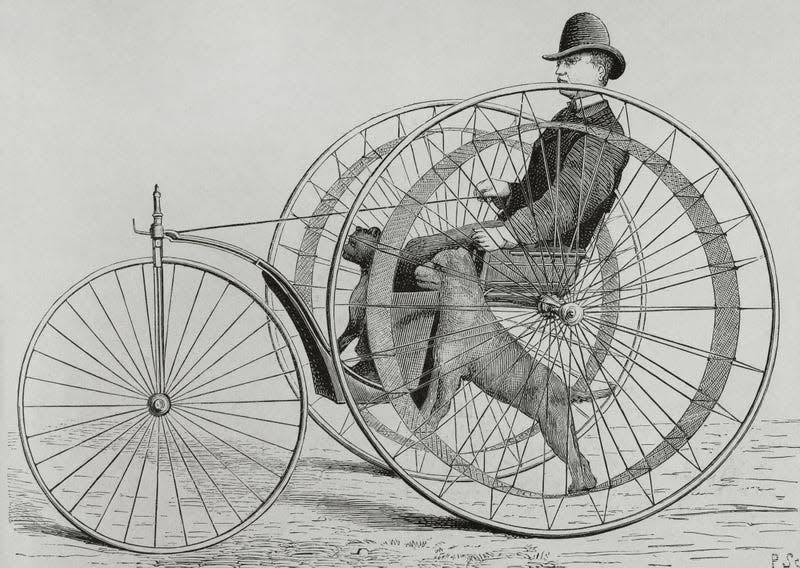
Ever since dogs were first domesticated about 18,000 years ago, they’ve often had jobs to earn their keep. Today, some dogs are used to herd sheep while others help hunters track and flush out game. And, believe it or not, dogs were sometimes used historically to power machines in private homes and factories.
Dog-powered machines were surprisingly common in 19th-century America, with dogs often walking on treadmills to power everything from meat-roasting spits to butter churns to various forms of transportation. They were common, at least, until evolving standards about what constitutes animal cruelty put a stop to the trend in the early 20th century.
The bizarre tricycle-style invention pictured above was created by Narcisse Huret in 1875 and presented at the Universal Exhibition (otherwise known as a World’s Fair) in Philadelphia for the U.S. Centennial in 1876. The device was powered by two dogs and apparently could reach a speed of roughly 6 miles per hour.
As author Andrew A. Robichaud notes in the 2019 book Animal City: The Domestication of America, dog-powered machines were being advertised for sale in the U.S. as early as the 1820s, and really hit their peak from 1840 to 1870. These machines helped make all kinds of products and were seen by many people as perfectly normal duties for dogs.
But times change. And attitudes around what’s an acceptable occupation for a dog changed with it. Even in the 19th century, it’s not hard to see why so many people started to consider these machines cruel. The treadmill, after all, was originally invented in 1817 as a torture device.
Click through the slideshow to take a look at some of the hard-working good boys and girls in history who helped humanity get the job done. And don’t forget to remind your own pampered dog how much harder their life would’ve been 200 years ago, as the TikTok meme so often reminds us.
Dog-Powered Churn
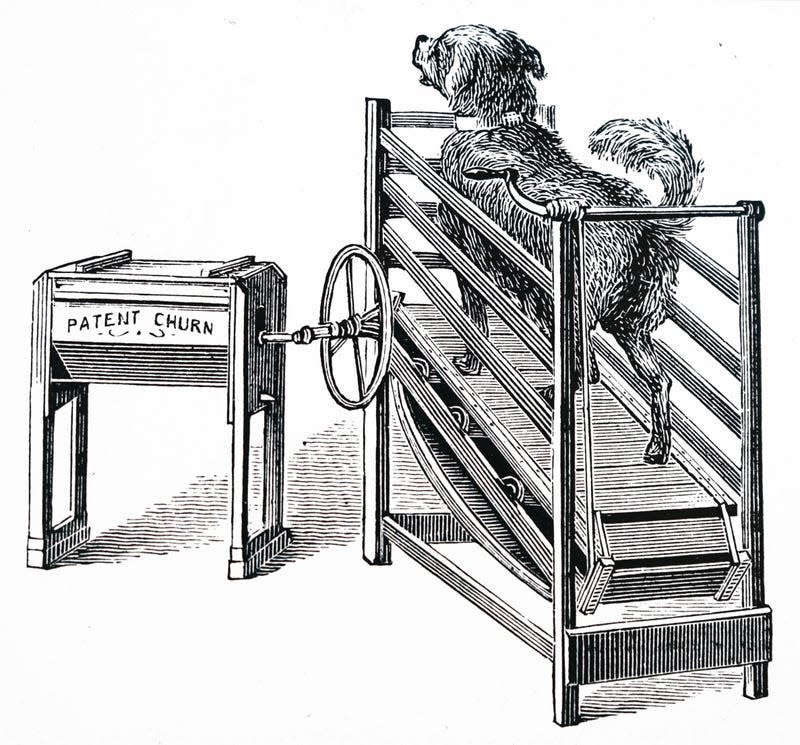
The most common dog-powered machines of the 19th century were utilizing treadmills that our canine friends would walk on. But the ultimate purpose of the machine could vary widely. In the image above, the machine was a churn.
The February 1849 issue of the magazine The Genesee Farmer mentioned an 11-foot wheel that was being marketed for powering various machines that weren’t just for churning:
This power is applied to a circular saw, a lathe, and several other operations, such as churning, pumping and washing. It is said to be much superior to the old one so long in use for churning.
But the second half of the 19th century saw even more applications than that.
Dog-Powered Water Pump
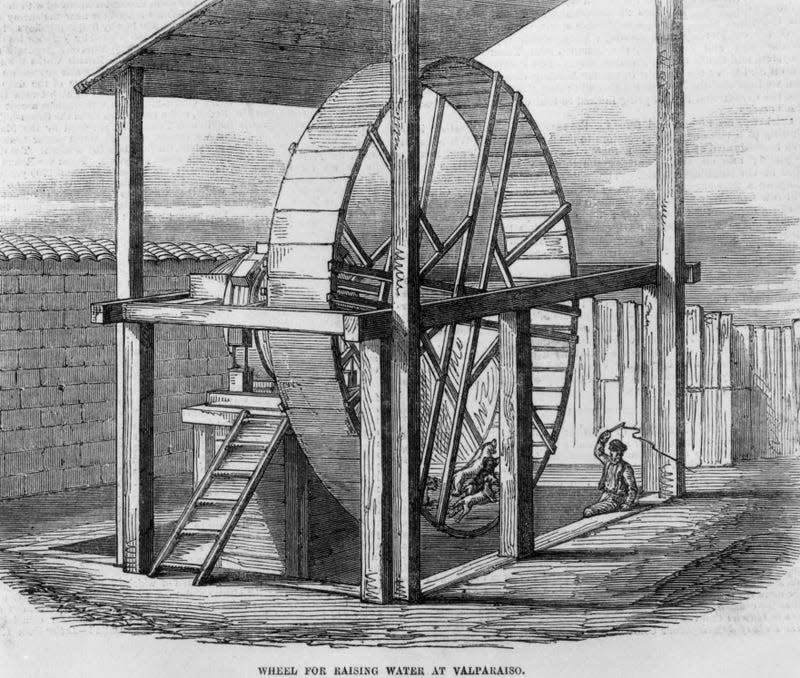
Another way that dog-powered machines helped humanity was by pumping water out of the ground, like in this report from Chile in the 1850s.
From the May 26, 1855 issue of the Illustrated London News:
This ingenious method of raising water from deep wells, by the means of dogs, has now, for a number of years, been the only way of supplying all English and foreign men-of-war and merchantmen, as well as almost the whole town of Valparaiso, with water.
The water is raised from the well by wooden buckets, emptying themselves on a table, from which, through pipes, the water is conveyed to launches, put into casks and buckets, and delivered to its various quarters.
The wheel raising the buckets is driven by eight dogs, belonging to Don Juan Augustine Vives: They continually run upwards, with perfect ease only four of the dogs work at a time; and when one is tired he jumps off, and another takes his place.
Obviously, you can see the whip being wielded against the dogs, perhaps explaining why this method of water pumping fell out of favor. Not very nice at all.
Turning Meat on a Spit Under Dog Power
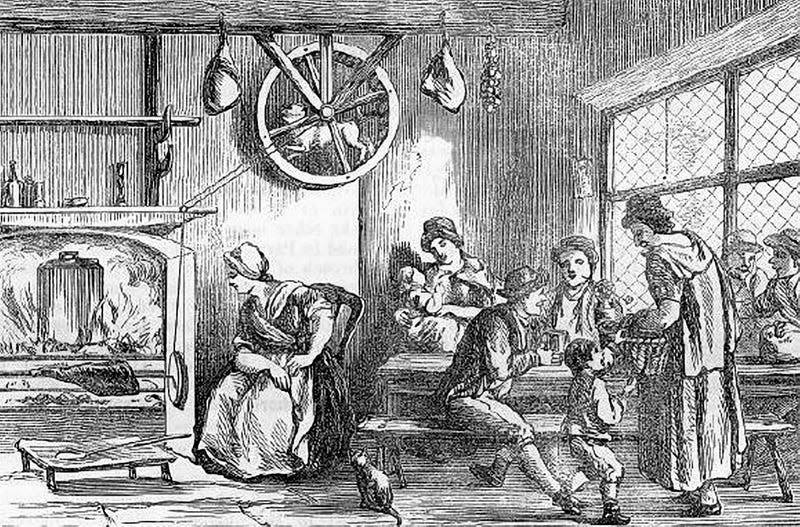
Back in the late 18th and early 19th century, cooking meat often happened by turning a spit over a fire. But constantly cranking the spit obviously could get tiring. That’s where dogs came in.
The 1853 book The Illustrated Natural History (Mammalia) by John George Wood explained how the dog-powered turnspit worked:
At one extremity of the spit was fastened a large circular box, or hollow wheel, something like the wire wheels which are so often appended to squirrel-cages: and in this wheel the Dog was accustomed to perform its daily task, by continually working. As the labour would be too great for a single Dog, it was usual to keep at least two animals for the purpose, and to make them relieve each other at regular intervals. The Dogs were quite able to appreciate the lapse of time, and, if not relieved from their toils at the proper hour, would leap out of the wheel without orders, and force their companions to take their place, and complete their portion of the daily toil.
The illustration above, which appeared in the 1799 book titled Remarks on a Tour to North and South Wales: in the year 1797 by Henry Wigstead, featured an illustration of the dog-powered spit. And it’s clear the illustrator wanted to communicate how this labor-saving invention was making things easier for humans.
Turnspit Breed of Dog
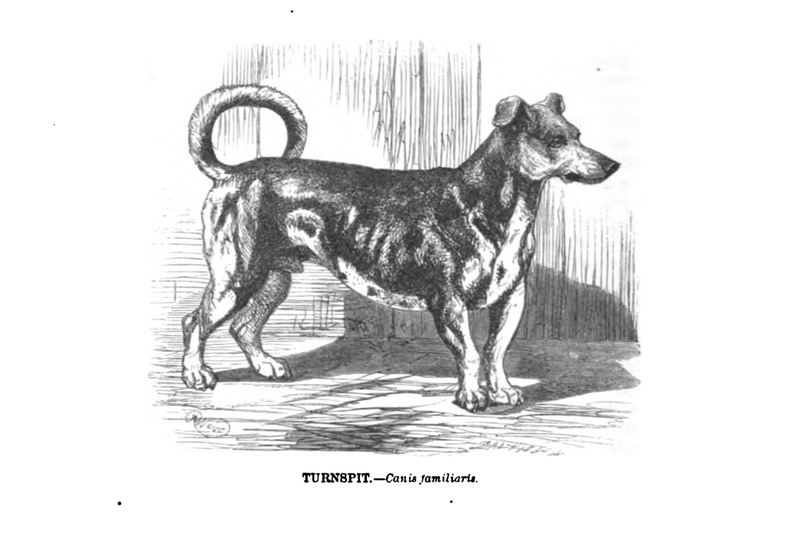
Dog-powered machines became so common in the early 19th century that specific breeds of dogs were created to ensure they were small and strong, like the Turnspit dog pictured above.
The 1853 book The Illustrated Natural History (Mammalia) by John George Wood explained that automated roasting jacks had become common enough, that few people used dogs to turn meat in their homes anymore by the middle of the 19th century. And the author noted how new technology, in this case a textile device called the spinning jenny, had put previous sewing technologies out of use.
Just as the invention of the spinning-jenny abolished the use of distaff and wheel, which were formerly occupants of every well-ordained English cottage, so the invention of automaton roasting-jacks has destroyed the occupation of the TURNSPIT DOG, and by degrees has almost annihilated its very existence. Here and there a solitary Turnspit may be seen, just as a spinning-wheel or a distaff may be seen in a few isolated cottages; but both the Dog and the implement are exceptions to the general rule, and are only worthy of notice as being curious relics of a bygone time.
The Turnspit dog no longer exists here in the 21st century, but they were pretty cool-looking guys, even if they had to work like hell to survive.
Dog-Powered Sewing Machine
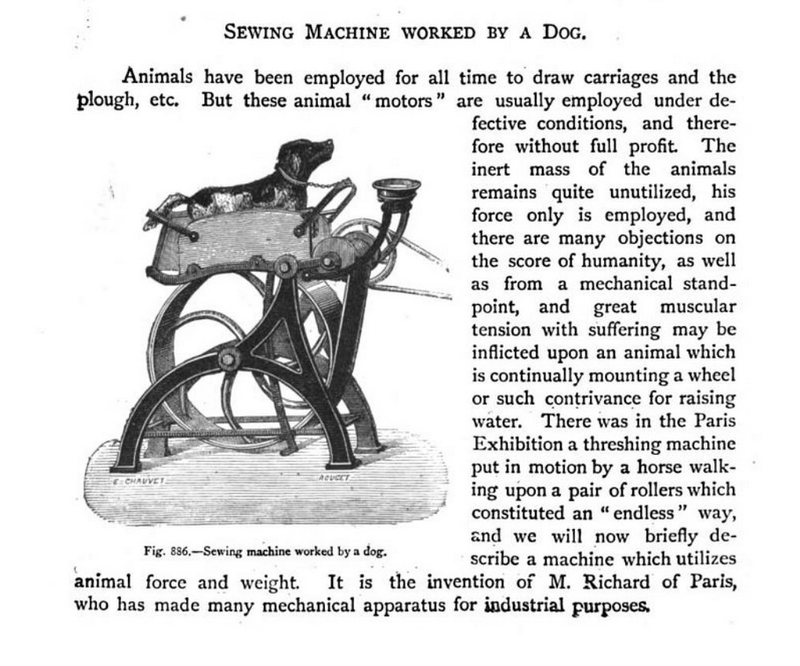
This invention of a dog-powered sewing machine was considered particularly cruel, as was noted in the 1882 book Popular Scientific Recreations. Again, as Andrew A. Robichaud mentions in his 2019 book Animal City: The Domestication of America, the heyday for dog-powered machines was 1840-1870, so it makes sense that by 1882 people were starting to become disturbed by these machines.
One Dog-Power Engine
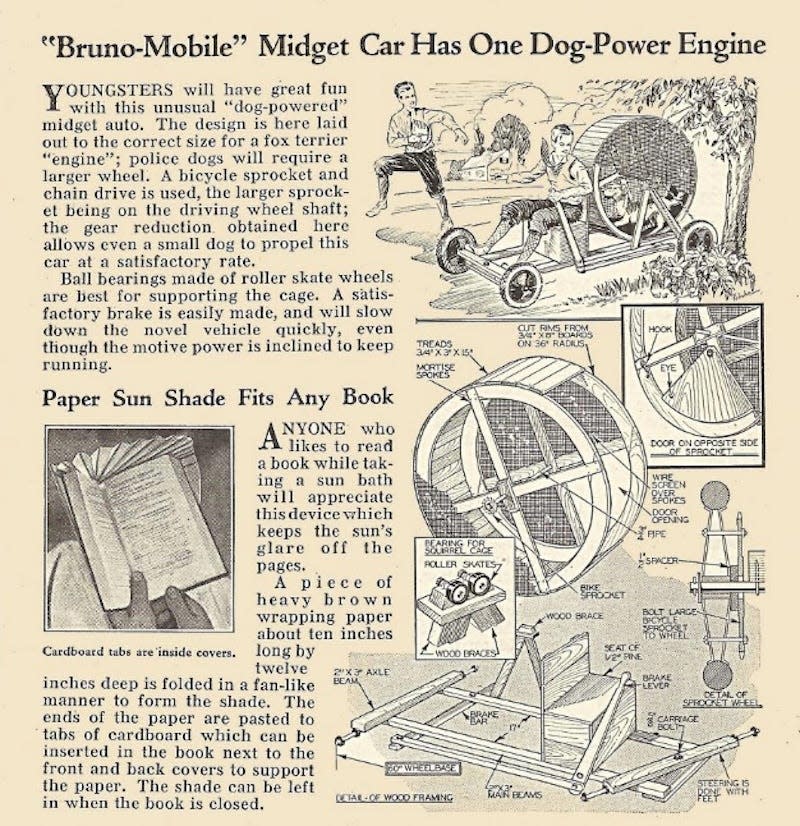
- Image: Internet Archive
Dog-powered machines didn’t necessarily go away by the 20th century. In fact, they were still pictured as a fun contrivance, as long as they were used for recreational activities where the dog could plausibly be having some fun, like in this idea from the June 1934 issue of Modern Mechanix magazine.
Knife-Sharpening Machine
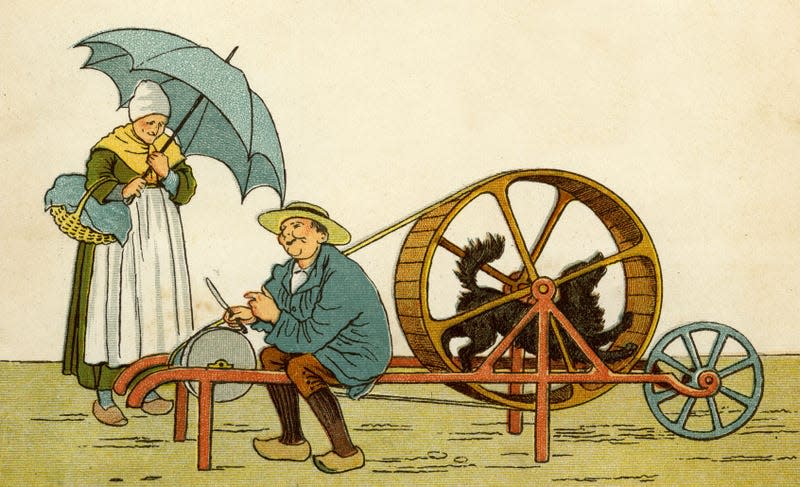
Another common dog-powered machine of the 19th century included knife-sharpening, something that wouldn’t necessarily be seen as very cruel given the relatively limited amount of time required to get the job done.
Modern Re-Imagining
There are a handful of people on YouTube who’ve built their own dog-powered machines, including someone who built a gigantic wheel that powers a blade sharpener, just as people were doing in the 19th century.
Canadian Working Dog
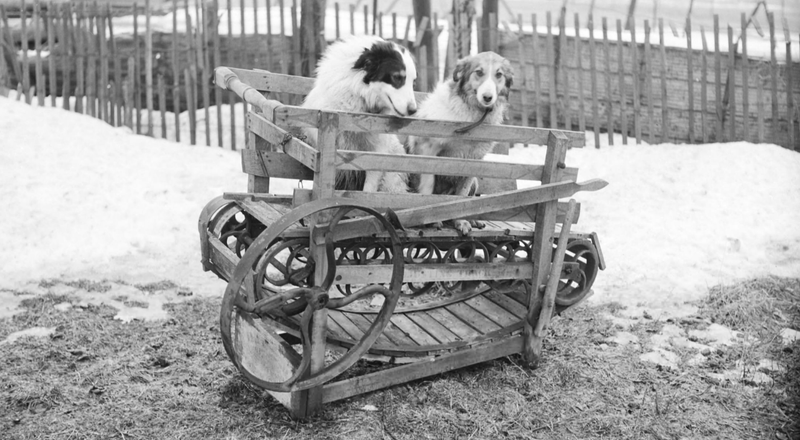
- Photo: University of Waterloo (Fair Use)
This photo was taken by a photographer for the Kitchener-Waterloo Record newspaper in Canada in 1954, though it’s not clear whether the machine was actually used at the time or existed more as a novelty for a photo-op.
Slide Title
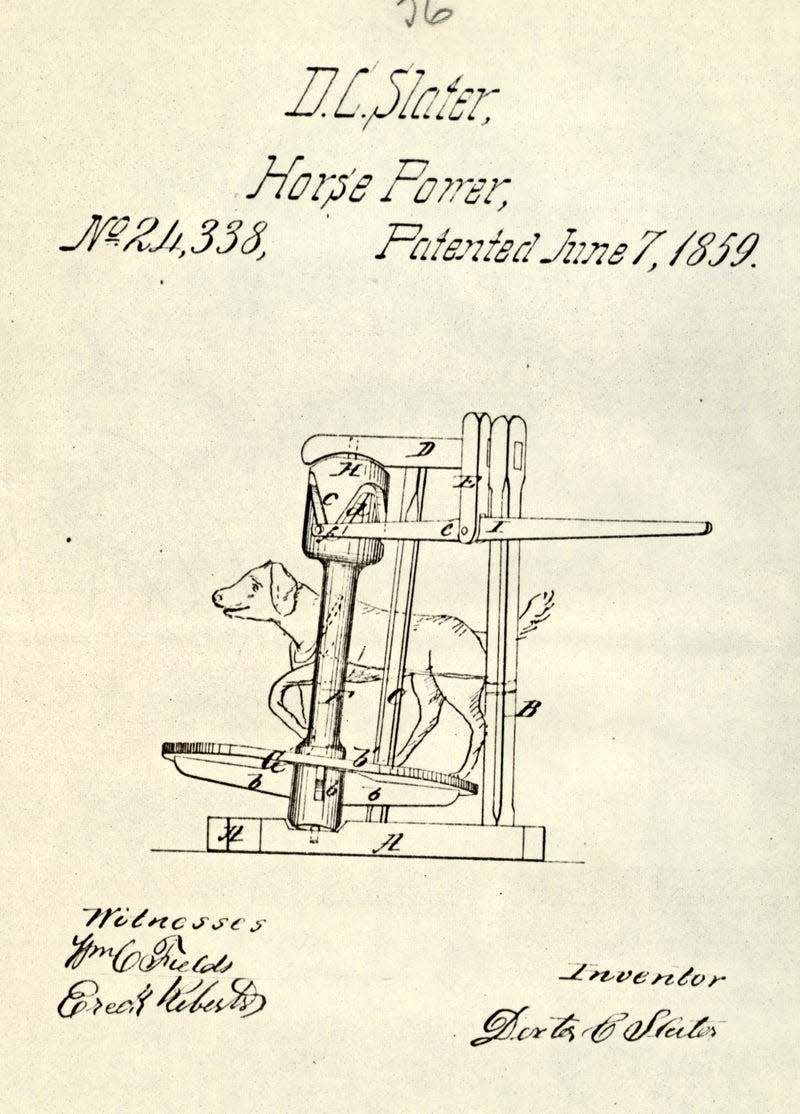
A number of different patents were granted for dog-powered machines in the 19th century, including the machine illustrated above for a pump.
Poor Boys
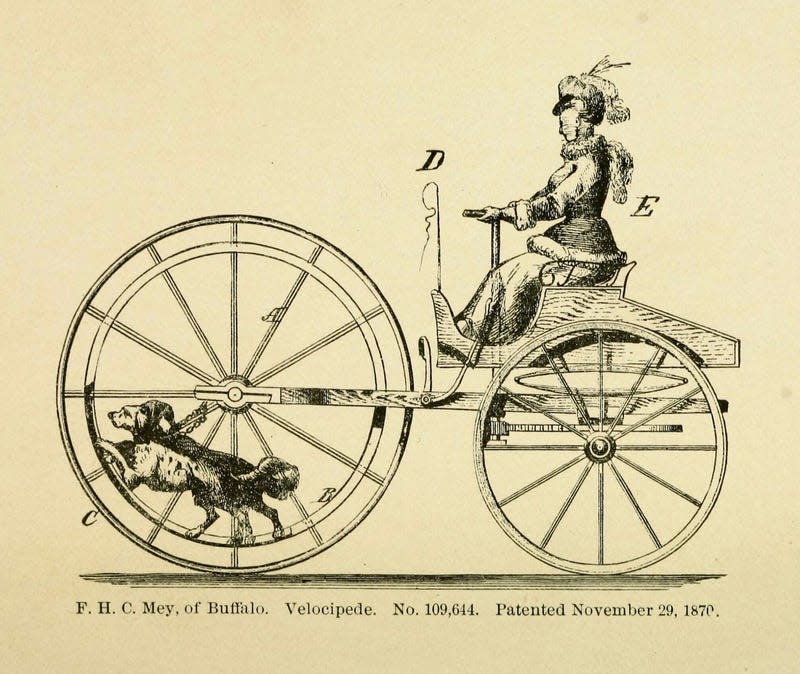
Much like the first image in this slideshow, there were a handful of dog-powered transportation vehicles, though they weren’t terribly efficient from an energy perspective. If this kind of thing worked well, The Flintstones would be a viable model for powering a car.
What appears notable in this invention is that the dogs very clearly have a chain attached to their neck, perhaps suggesting the dogs were not very happy with the situation and would presumably run off at any chance they got.
Butter ‘em Up
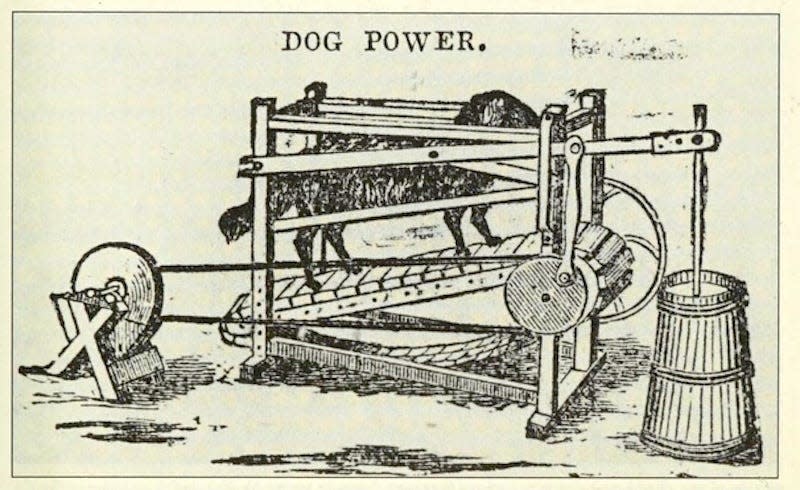
This ad for a dog-powered butter churn device comes from the 1850s and is featured in the book Working Like a Dog: The Story of Working Dogs Through History (2003) by Gena Gorrell. Again, churning butter could be an exhausting task for humans, and the middle of the 19th century tried to solve that problem by using dogs.
From Serious Work to Entertainment
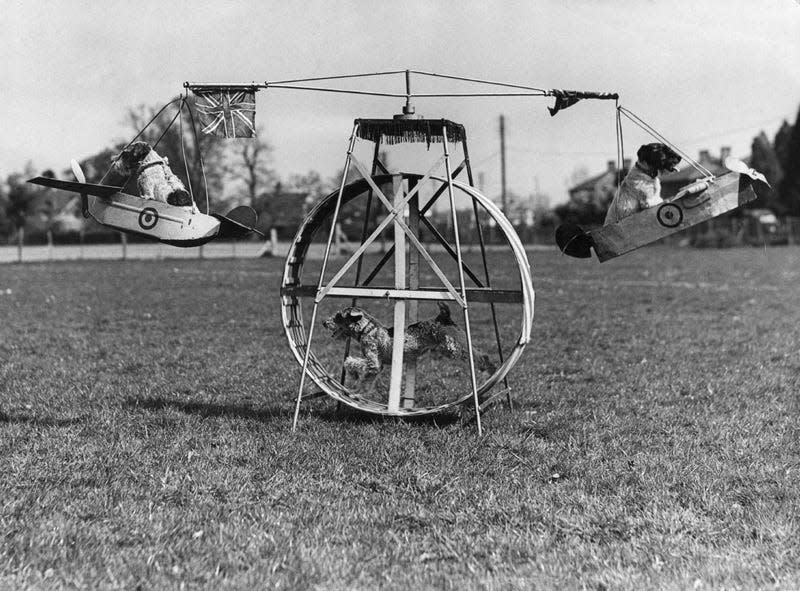
By the middle of the 20th century, most of the serious work machines had vanished, but there were still some very cool designs for similar machines used for entertainment purposes. Look at how much fun they’re having. Now that’s a dog-powered machine we can feel good about.

